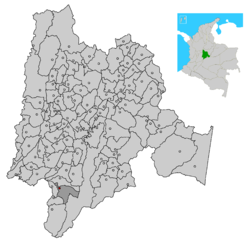
San Bernardo, Cundinamarca
Encyclopedia


Colombia
Colombia, officially the Republic of Colombia , is a unitary constitutional republic comprising thirty-two departments. The country is located in northwestern South America, bordered to the east by Venezuela and Brazil; to the south by Ecuador and Peru; to the north by the Caribbean Sea; to the...
in the department
Departments of Colombia
Colombia is an unitary republic formed by thirty-two departments and a Capital District . Each department has a Governor and a Department Assembly , elected by popular vote for a four-year period. The governor cannot be re-elected in consecutive periods...
of Cundinamarca
Cundinamarca Department
- Origin of the name :The name of Cundinamarca comes from Kundur marqa, an indigenous expression, probably derived from Quechua. Meaning "Condor's Nest", it was used in pre-Columbian times by the natives of the Magdalena Valley to refer to the nearby highlands....
. This town is located 99 km from Santa Fe de Bogota. It is characterized as an agricultural pantry area due to the high fertility of the land and variety of climates. San Bernardo main products are Blackberry
Blackberry
The blackberry is an edible fruit produced by any of several species in the Rubus genus of the Rosaceae family. The fruit is not a true berry; botanically it is termed an aggregate fruit, composed of small drupelets. The plants typically have biennial canes and perennial roots. Blackberries and...
and Pea
Pea
A pea is most commonly the small spherical seed or the seed-pod of the pod fruit Pisum sativum. Each pod contains several peas. Peapods are botanically a fruit, since they contain seeds developed from the ovary of a flower. However, peas are considered to be a vegetable in cooking...
, renowned for its excellent quality.
Due to its location on the Andes
Andes
The Andes is the world's longest continental mountain range. It is a continual range of highlands along the western coast of South America. This range is about long, about to wide , and of an average height of about .Along its length, the Andes is split into several ranges, which are separated...
the weather conditions are ruled by the altitude and also by the wind from the Páramo Sumapaz, this affect the temperature cooling some areas of the municipallity, specially at night, but also providing mild weather in some other areas hence being at high altitude.
Tourism
The great natural landscapes are accompanied by agricultural pictorial scenes, water flows and springs as well. It is recognized for the great variety of native vegetation, flowers and birds.Events and Places
- Fairs and Festivals (held at the end of June and early July, have great appreciation for good quality and organization).- Principal Church.
- Historic Roads.
- Cemetery.
- The mausoleum of the Natural Mummies. (Well preserved mummies could be seen at this place. Although several theories around, it is still an enigma the phenomenon of natural mummification in the cemetery)
- Cerro Paquilo.
- Natural caves.
- Piedra del Sol (rock in the sidewalk "El Carmen" with prehispanic indigenous petroglyphs ).
- The Lajas
- Mirador of Portones.
- Water Treatment Plant. Floral displays.
- The Market (Offers the opportunity to find the great variety of fruits and vegetables produced in the region). Sunday is its busiest day.
- The food hall (A set of kiosks that offer typical Colombian food)
History
San Bernardo was born from a vast amount of mountain terrain colonized to 1910 on July 22 in the morning when the father Mazo celebrated Mass and said the town was founded in honor of Monsignor Bernardo Herrera, was blessed that day the bells of Chapel was donated by General Charles J. Heredia.In January 1913, the first party enlivened by the band Espinal. The municipality of Pandi in 1914 it stood at corregimiento. By Ordinance No. 66, April 30, 1920 emerged as the municipality, the municipality of Pandi segregated, plus the district of Nazareth, was sentenced by the Governor Eduardo Restrepo Saenz and regulated by Decree 289 of June 23, 1921. The first mayor was Miguel Mena.
The tribunal ruling by June 30 of 1923 declared null and that the ordinance under the Gobernandor Eduardo Briceño by Decree 1254 of August 14, 1923 abolished the town reintegrating Pandi and Bogota. For Ordennaza No. 62, May 3, 1927 was definitely the municipality and the mayor was Malo Daniel O Leary. The parish was established by decree of January 29, 1932 Archbishop Ismael Perdomo

